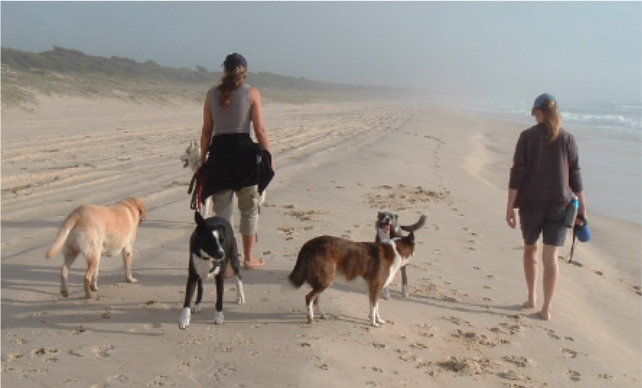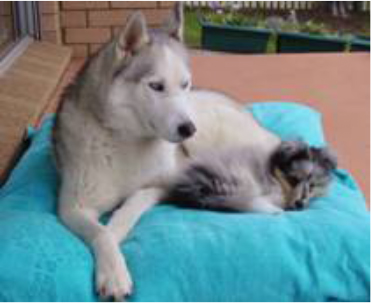The Art of Introducing Dogs (8 page)
Read The Art of Introducing Dogs Online
Authors: Louise Ginman

Ensure the dogs are exercised daily to keep them content and keep arousal levels lower at home. By exercising the dogs together you are helping them to form social bonds by engaging in an activity together — whether going for a walk or going to the dog park. It is ideal if someone can assist you while walking the dogs in these early stages of living together. Walking two dogs requires greater skills than walking one dog. Sudden high arousal levels from either dog to external stimuli while being walked by one person could lead to displacement aggression between the dogs. It is also far harder to do training on your walks when you are trying to manage two dogs on lead. If you do not have anyone to assist you, it may be best to walk each dog separately until you know what behaviour to expect from your new dog — e.g. does she bark at other dogs, passing vehicles or other fast moving objects. If so, you will need to begin a desensitisation and counterconditioning program to decrease the dogs’ reaction before embarking on walking both dogs together on your own. It is far harder to treat any on lead issues when you are walking two dogs. Dogs that are mildly reactive on lead may become even more reactive now that they have another dog to support them. Work through these initial teething problems and seek assistance if required so you all can enjoy your walks together.

Going for daily walks is a great way to assist your dogs to bond as well as getting vital exercise and socialisation. These dogs are enjoying a visit to a dog friendly beach.
Naturally you will have to go back to work one day, or go out shopping etc., so the dogs will eventually need to learn how to stay home on their own without you being around to supervise them. Plan to be home for the first 5–6 days of bringing the new dog or pup home to provide constant supervision so that the dogs have you around at all times to monitor and manage their interactions. This time can also be spent teaching the rules of the house to the new comer. This is especially important if you brought a puppy home as toilet training will be high on your list and require constant supervision and diligence to prevent accidents. After this initial period, and once the dogs have settled into your home and things are progressing well, they will need to begin to be left home alone together. The following plan is for dogs that will be left home alone together in an outdoor fully fenced yard. For crated or indoor dogs you simply need to modify the plan to suit your own individual circumstances.
Leaving the dogs home alone for short periods of time and slowly building up their ‘alone’ time will assist to ease the dogs into this routine and hopefully minimize any distress that one or both may feel when you are not around as well as while learning to live together.

Apart from hiding in the house to see if your dog’s settle while you are away, another great way to monitor how they are going is to set up a video camera strategically e.g. near a window, to record their behaviour when you are not home. This allows you to see how each dog is spending his or her time plus hear any crying or barking. If you don’t have a video camera, try borrowing one from a friend for a few days. Alternatively you can buy one or two small wireless cameras quite cheaply and use your computer or video recorder to monitor your dog’s behaviour. Another simple way is to tell your neighbors about your home alone schedule so that they can also report back to you about how it is all going. Again planning is the key to a successful transition from having constant supervision to spending time home alone together.
Preparation for being home alone together?
 Work out the number of hours that your dogs are required to spend home alone and the number of days you have to reach this target. E.g. the total number of hours the dogs need to be able to spend alone is 11 hours per day with 20 days to reach that target.
Work out the number of hours that your dogs are required to spend home alone and the number of days you have to reach this target. E.g. the total number of hours the dogs need to be able to spend alone is 11 hours per day with 20 days to reach that target.
 If your dogs can be given food unsupervised, aim to provide 3 to 4 enrichment items to each dog when you leave them home alone. For enrichment ideas see
If your dogs can be given food unsupervised, aim to provide 3 to 4 enrichment items to each dog when you leave them home alone. For enrichment ideas see
Appendix B
. Start with low value food items.
 Trial all enrichment items several times and show the dogs how to use them before leaving them unsupervised.
Trial all enrichment items several times and show the dogs how to use them before leaving them unsupervised.
 If safe to do so, provide several toys in addition to the other forms of enrichment and rotate the toys to keep them fun and interesting.
If safe to do so, provide several toys in addition to the other forms of enrichment and rotate the toys to keep them fun and interesting.
 Only give these enrichment items and associated treats when the dogs will be left home alone. This helps to make your absence fun, special and something to look forward to.
Only give these enrichment items and associated treats when the dogs will be left home alone. This helps to make your absence fun, special and something to look forward to.
 When leaving the dogs, keep all comings and goings calm. Leaving and coming home should be non-events rather than exciting ones to help keep the dogs emotions under control.
When leaving the dogs, keep all comings and goings calm. Leaving and coming home should be non-events rather than exciting ones to help keep the dogs emotions under control.
 Turn on your ‘Through a Dogs Ear’ music CD to create a calming atmosphere.
Turn on your ‘Through a Dogs Ear’ music CD to create a calming atmosphere.
 For all separations, call the dogs outside, put the enrichment items around the yard, quietly say goodbye — this becomes the cue that you are leaving and that good stuff is about to happen. Leave the same way that you will when you go to work or go out.
For all separations, call the dogs outside, put the enrichment items around the yard, quietly say goodbye — this becomes the cue that you are leaving and that good stuff is about to happen. Leave the same way that you will when you go to work or go out.
